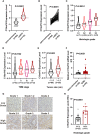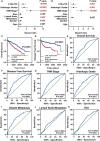The Clinical Relevance and Tumor Promoting Function of C19orf10 in Kidney Renal Clear Cell Carcinoma
- PMID: 34552877
- PMCID: PMC8451477
- DOI: 10.3389/fonc.2021.725959
The Clinical Relevance and Tumor Promoting Function of C19orf10 in Kidney Renal Clear Cell Carcinoma
Abstract
Kidney renal clear cell carcinoma (KIRC) is the most common primary renal neoplasms. Currently, there are few molecular indicators and therapeutic targets that can be used in diagnostic and prognostic assessment. In this study, we identified the C19orf10 expression in KIRC specimens and explored the diagnostic and prognostic value of C19orf10 in KIRC using TCGA and CPTAC database. Loss-of- and gain-of- function of C19orf10 was performed to investigate the roles of C19orf10 on KIRC cell viability, proliferation, migration and invasion via CCK-8, Edu incorporation and Transwell assays respectively. C19orf10 was overexpressed in KIRC tissues and the elevated C19orf10 expression was closely associated with clinicopathological characteristics of KIRC including histological grade, TNM stage, metastatic status. Silencing C19orf10 significantly suppressed the viability, proliferation, migration and invasion ability, while overexpression of C19orf10 promoted the progression and malignant phenotype in KIRC cells. Furthermore, C19orf10 exerted its carcinogenic function by regulating ZO-1 and PTEN/Akt signaling pathway. Moreover, the Kaplan-Meier survival analysis, Cox regression analysis and receiver operating curve analysis showed that patients with C19orf10 overexpression have poor survival time. C19orf10 could discriminate KIRC patients with high-risk from low-risk. Taken together, C19orf10 contributes to KIRC development via ZO-1 and PTEN/Akt signaling pathway and C19orf10 could serve as a potential diagnostic and prognostic candidate and therapeutic target of KIRC.
Keywords: C19orf10; PTEN/Akt; ZO-1; diagnostic biomarker; kidney renal clear cell carcinoma; prognostic biomarker.
Copyright © 2021 Lu, Liao, Wang, Hong and Li.
Conflict of interest statement
The authors declare that the research was conducted in the absence of any commercial or financial relationships that could be construed as a potential conflict of interest.
Figures







Similar articles
-
C19orf10 promotes malignant behaviors of human bladder carcinoma cells via regulating the PI3K/AKT and Wnt/β-catenin pathways.J Cancer. 2021 May 19;12(14):4341-4354. doi: 10.7150/jca.56993. eCollection 2021. J Cancer. 2021. PMID: 34093834 Free PMC article.
-
Diagnostic and prognostic role of basic leucine zipper transcription factor in kidney renal clear cell carcinoma.Transl Androl Urol. 2022 Feb;11(2):238-252. doi: 10.21037/tau-21-1130. Transl Androl Urol. 2022. PMID: 35280662 Free PMC article.
-
OCLN as a novel biomarker for prognosis and immune infiltrates in kidney renal clear cell carcinoma: an integrative computational and experimental characterization.Front Immunol. 2023 Sep 22;14:1224904. doi: 10.3389/fimmu.2023.1224904. eCollection 2023. Front Immunol. 2023. PMID: 37809090 Free PMC article.
-
miR-21-5p/PRKCE axis implicated in immune infiltration and poor prognosis of kidney renal clear cell carcinoma.Front Genet. 2022 Sep 13;13:978840. doi: 10.3389/fgene.2022.978840. eCollection 2022. Front Genet. 2022. PMID: 36186442 Free PMC article.
-
Long Non-Coding RNA LUCAT1 Promotes Proliferation and Invasion in Clear Cell Renal Cell Carcinoma Through AKT/GSK-3β Signaling Pathway.Cell Physiol Biochem. 2018;48(3):891-904. doi: 10.1159/000491957. Epub 2018 Jul 20. Cell Physiol Biochem. 2018. PMID: 30032137
Cited by
-
Cellular hierarchy framework based on single-cell and bulk RNA sequencing reveals fatty acid metabolic biomarker MYDGF as a therapeutic target for ccRCC.Front Immunol. 2025 Jun 5;16:1615601. doi: 10.3389/fimmu.2025.1615601. eCollection 2025. Front Immunol. 2025. PMID: 40539074 Free PMC article.
-
Myeloid-derived growth factor in diseases: structure, function and mechanisms.Mol Med. 2024 Jul 19;30(1):103. doi: 10.1186/s10020-024-00874-z. Mol Med. 2024. PMID: 39030488 Free PMC article. Review.
-
Nonsense-Mediated Decay Targeted RNA (ntRNA): Proposal of a ntRNA-miRNA-lncRNA Triple Regulatory Network Usable as Biomarker of Prognostic Risk in Patients with Kidney Cancer.Genes (Basel). 2022 Sep 15;13(9):1656. doi: 10.3390/genes13091656. Genes (Basel). 2022. PMID: 36140823 Free PMC article.
-
The Rapid Activation of MYDGF Is Critical for Cell Survival in the Acute Phase of Retinal Regeneration in Fish.Int J Mol Sci. 2025 Jul 27;26(15):7251. doi: 10.3390/ijms26157251. Int J Mol Sci. 2025. PMID: 40806387 Free PMC article.
References
LinkOut - more resources
Full Text Sources
Research Materials
Miscellaneous

